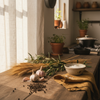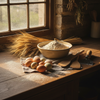Best Reusable Snack Bags For Lunches Without Toxins
Redefining Lunch,One Snack Bag at a Time
Picture this: You're standing in your kitchen at 7 AM, coffee in hand, staring at a drawer full of crumpled plastic baggies that have seen better days. Sound familiar? If you're a home chef who dreams big,whether you're perfecting sourdough or simply trying to pack a lunch that doesn't leak all over your bag,you've probably wondered if there's a better way.
Key Takeaways
- Many people start their day frustrated with the mess and waste of disposable plastic snack bags.
- Reusable snack bags offer a practical alternative for packing lunches without leaks.
- Home chefs seek better solutions to make lunch packing easier and more sustainable.
- There is a growing interest in eco-friendly and toxin-free lunch storage options.
Table of Contents
- Redefining Lunch,One Snack Bag at a Time
- Understanding Reusable Snack Bags: The Modern Lunch Essential
- How Reusable Snack Bags Make Life Better (And Greener)
- How to Choose the Best Reusable Snack Bag for Your Needs
- DI ORO's Top Picks: The Best Reusable Snack Bags for Every Lunchbox
- Key Features to Consider: Snack Bag Showdown,Side-by-Side Comparisons
- How-To Guides for Snack Bag Success
- Common Problems & Clever Solutions
- Reusable Snack Bags vs. the Competition: A Lunchroom Smackdown
- Level Up Your Lunch: Pro Tips and Advanced Ideas
- DI ORO's Culinary Commitment: Cooking Boldly & Safely for Life
- Conclusion: The Confident, Inspired Lunchbox
There absolutely is, and it starts with reusable snack bags for lunches.
The shift toward reusable lunch solutions isn't just about being eco-conscious (though that's a beautiful bonus). It's about empowering yourself as a kitchen creator who refuses to settle for flimsy, wasteful tools that can't keep up with your culinary ambitions. Whether you're a parent packing school lunches, a meal-prep enthusiast, or someone who simply believes that what touches your food should be as clean as your conscience, reusable snack bags are your ticket to lunch liberation.
The DI ORO Difference: Just like our award-winning spatulas that earned recognition from America's Test Kitchen, the best reusable snack bags should meet the same gold standard,forever-chemical free, built to last, and designed with your health in mind. Because what touches your food matters, whether it's a spatula or a sandwich bag.
Here's what switching to reusable snack bags brings to your kitchen game:
- Cost savings that add up: One quality reusable bag replaces hundreds of disposable ones
- Creativity unleashed: Better seals mean you can pack soups, dips, and messy favorites without fear
- Confidence in every bite: No more wondering what chemicals might be leaching into your food
- Durability you can trust: The best bags handle everything from freezer storage to dishwasher cleaning
This guide will walk you through everything you need to know to choose the perfect reusable snack bags for your lifestyle. We'll cover the materials that matter (spoiler: not all silicone is created equal), maintenance made simple, and our top picks for every type of lunch-packer. Plus, we'll share the DI ORO philosophy on why investing in quality kitchen tools,from spatulas to snack bags,transforms not just your meals, but your entire cooking confidence.
Ready to upgrade your lunch game? Let's dive in.
Understanding Reusable Snack Bags: The Modern Lunch Essential

What Are Reusable Snack Bags?
A reusable snack bag is exactly what it sounds like,a durable, washable container designed to replace single-use plastic bags for food storage and transport. But here's where it gets interesting: the best reusable snack bags aren't just plastic bag replacements. They're upgrade tools that can handle hot foods, acidic ingredients, and even sous vide cooking in some cases.
Unlike traditional plastic baggies that tear, leak, and contribute to landfill waste, quality reusable bags are engineered to withstand hundreds of uses while maintaining their seal integrity and food safety standards. Think of them as the difference between a flimsy spatula that melts on your pan and a DI ORO spatula that's built to handle 600°F without breaking a sweat.
Quick comparison: Disposable plastic bags are designed for single use and often contain concerning chemicals. Reusable snack bags are built for longevity, safety, and versatility,handling everything from dry crackers to wet yogurt with equal confidence.
The Material World: Snack Bag Materials Explained
Just like choosing between different spatula materials, understanding snack bag materials is crucial for making the right choice. Here's your material breakdown:
Silicone: The Gold Standard
Premium silicone bags (especially platinum-grade silicone) represent the pinnacle of reusable bag technology. This is the same type of pro-grade, forever-chemical-free silicone that makes DI ORO spatulas the choice of America's Test Kitchen. Silicone bags are heat-resistant, often handling temperatures from freezer (-40°F) to oven (up to 400°F in some cases), and they're naturally non-porous, which means bacteria can't hide in tiny cracks.
DI ORO Authority Note: Our award-winning spatulas use the same principles that make great silicone snack bags,LFGB certification, BPA-free construction, and zero forever chemicals. When America's Test Kitchen calls our spatulas "Most Versatile" and "Best All-Purpose," it's because we understand what food-safe silicone should be.
PEVA: The Budget-Friendly Alternative
PEVA (polyethylene vinyl acetate) offers a middle ground between disposable plastic and premium silicone. It's flexible, lightweight, and significantly more affordable than silicone while still being reusable and recyclable. However, PEVA bags typically can't handle heat and may not last as long as their silicone counterparts.
Fabric: The Kid-Friendly Choice
Fabric-based reusable bags, often made from cotton with TPU (thermoplastic polyurethane) lining, excel at dry snack storage. They're perfect for crackers, sandwiches, and fruit, plus kids love the fun patterns. The downside? They're not suitable for liquids or messy foods, and cleaning can be more involved.
Beeswax Wraps: The Zero-Waste Warrior
Technically not bags but worth mentioning, beeswax wraps offer a completely natural, compostable option. They work through the warmth of your hands, molding around food to create a seal. Perfect for the environmentally conscious cook, though they require more care and aren't suitable for raw meat or very wet foods.
Why Go Reusable?
The case for reusable snack bags extends far beyond environmental consciousness, though the environmental impact is staggering. The average American family uses over 500 plastic bags per year just for food storage. That's 500 opportunities for chemicals to potentially leach into your food, 500 pieces of waste heading to landfills, and money literally thrown away.
But here's what really matters for kitchen creators like you:
Health and Trust: Many disposable plastic bags contain phthalates, BPA, and other chemicals that can migrate into food, especially when exposed to heat or acidic ingredients. Quality reusable bags eliminate this concern entirely. Just like DI ORO's commitment to forever-chemical-free silicone in our spatulas, the best reusable bags prioritize your health over convenience.
Versatility Beyond Snacks: Premium reusable bags aren't just for school lunches. Use them for marinating meats (the seal prevents cross-contamination), storing leftovers, organizing travel items, or even as sous vide bags for precision cooking. It's the same principle that makes our award-winning spatulas so valuable,one quality tool that handles multiple kitchen tasks.
Chef's Insight: The best kitchen tools are the ones that make you more creative, not more limited. A quality reusable bag opens up possibilities,from packing delicate pastries without crushing to storing homemade dressings without leaks. That's the kind of confidence every home chef deserves.
How Reusable Snack Bags Make Life Better (And Greener)
Let's talk about the real-world impact of making the switch. When you choose reusable snack bags, you're not just buying a product,you're investing in a system that supports your creativity, protects your health, and simplifies your routine.
Cutting Waste, Saving Cash: A single quality reusable bag can replace hundreds of disposable ones over its lifetime. If your family currently spends $50 annually on plastic bags (a conservative estimate), switching to reusable options pays for itself within the first year while eliminating ongoing waste.
Protecting What Matters: Your food,and by extension, your family's health,deserves the same level of protection you'd expect from any kitchen tool. Forever-chemical-free materials mean you can pack acidic foods like tomatoes or citrus without worrying about chemical leaching. It's the same philosophy that drives DI ORO's commitment to pro-grade, LFGB-certified silicone in our spatulas.
Empowering Creativity: Better seals and durability mean you can finally pack that homemade soup for lunch, send yogurt with fresh berries without soggy disasters, or prep marinated vegetables ahead of time. No more "lunch rut" because your storage can't keep up with your culinary ambitions.
The confidence that comes from using tools you trust,whether it's a spatula that won't melt or a snack bag that won't leak,transforms how you approach food preparation. Suddenly, packing lunch becomes less about damage control and more about culinary expression.
How to Choose the Best Reusable Snack Bag for Your Needs

Choosing the right reusable snack bags for lunches is like selecting the perfect spatula,it's all about matching the tool to your specific cooking style and needs. Just as you wouldn't use a delicate crepe spatula for heavy-duty burger flipping, different snack bags excel in different scenarios.
Bag Size & Shape: Matching Container to Contents
Size matters when it comes to reusable snack bags, and getting it right prevents food waste while maximizing freshness. Here's your sizing guide:
- Snack size (3-4 oz): Perfect for nuts, berries, crackers, or small portions of cut vegetables
- Sandwich size (7-8 oz): The workhorse of lunch packing,handles sandwiches, wraps, larger fruit portions
- Quart size (32 oz): Ideal for salads, meal prep portions, or family-style snacks
- Gallon size (128 oz): Your meal prep champion for batch cooking, marinating, or storing leftovers
Pro Tip: Just like DI ORO's spatula collection offers different sizes for different tasks, invest in a variety pack. Most home chefs find that having 2-3 sandwich bags, 4-5 snack bags, and 1-2 larger bags covers 95% of their storage needs.
Shape considerations go beyond just size. Stand-up pouches work brilliantly for liquids and soups, while flat bags maximize space efficiency in lunch boxes. Specialty shapes like reusable baby food pouches feature spill-proof spouts, making them perfect for applesauce, smoothies, or reusable yogurt pouches that kids can manage independently.
Material Deep Dive: The Complete Comparison
Understanding materials is crucial for making an informed choice. Here's your comprehensive comparison table:
| Material | Temperature Range | Durability | Cleaning | Best For | Price Range |
|---|---|---|---|---|---|
| Platinum Silicone | -40°F to 400°F | Excellent (2+ years) | Dishwasher safe | All foods, hot/cold, liquids | $$$ (Premium) |
| PEVA | -10°F to 158°F | Good (1-2 years) | Hand wash recommended | Dry snacks, sandwiches | $ (Budget) |
| Fabric/TPU | Room temperature only | Good (1-2 years) | Machine washable | Dry snacks, kid-friendly | $$ (Mid-range) |
| Beeswax | Room temperature only | Fair (6-12 months) | Cold water only | Bread, cheese, produce | $$ (Mid-range) |
| Verdict: Platinum silicone offers the best versatility and longevity, making it the top choice for serious home chefs who want one solution for multiple needs. | |||||
Seal and Closure Types: What Makes a Bag Truly Leakproof
The closure mechanism determines whether your reusable sandwich bag becomes a trusted kitchen ally or a lunchtime disaster. Here's what you need to know:
Press-Seal/Ziplock Style: The most familiar option, featuring interlocking ridges that create an airtight seal. Quality versions use thicker, more durable plastic that maintains seal integrity over hundreds of uses. Look for double-track seals for extra security with liquids.
Pinch-Lock Sliders: These feature a sliding mechanism that compresses the bag opening. They're particularly effective for one-handed operation and create excellent seals, making them ideal for reusable yogurt pouches or soup storage.
Leakproof Reality Check: True leakproof performance depends on both seal design and material quality. Even the best closure won't save a bag made from thin, flexible material that stretches over time. This is why premium silicone bags consistently outperform budget alternatives,the material maintains its shape and seal integrity.
Roll-Top Closures: Popular in outdoor gear, these closures fold over multiple times before clipping shut. They're excellent for dry goods and create a very secure seal, though they're less convenient for frequent access.
Ease of Cleaning: Making Maintenance Hassle-Free
The best reusable snack bag is worthless if it's too annoying to clean. Here's what separates the champions from the pretenders:
Dishwasher Compatibility: Premium silicone bags handle dishwasher cycles without degrading, making cleanup as simple as loading your other dishes. This is the same durability principle that makes DI ORO spatulas dishwasher-safe,quality materials shouldn't require special treatment.
Interior Accessibility: Wide openings and bags that turn inside-out completely make thorough cleaning possible. Narrow-mouth bags or those with complex internal structures trap food particles and become hygiene nightmares.
Chef's Insight: Transparency matters for more than just seeing contents. Clear materials let you visually confirm cleanliness, while opaque bags can hide residue that leads to odors and bacterial growth.
Design & Style: Function Meets Form
While performance comes first, design elements can significantly impact your daily experience with reusable bags:
Kid-Pleasing Elements: Bright colors, fun patterns, and easy-grip textures help children take ownership of their lunch routine. Some bags feature writable surfaces for labeling or personalization.
Professional Aesthetics: Minimalist designs in neutral colors work better in office environments, while clear windows let you identify contents without opening bags.
Color-Coding Systems: Different colored bags for different family members or food types (red for proteins, green for vegetables) streamline meal prep and prevent cross-contamination.
Eco & Safety Credentials: What Certifications Actually Mean
Not all "BPA-free" claims are created equal. Here's how to decode safety certifications:
- LFGB Certified: German food safety standard that's more rigorous than FDA requirements
- BPA and Phthalate-Free: Minimum standard, but doesn't guarantee absence of other concerning chemicals
- Forever-Chemical-Free: Specifically excludes PFAS and similar persistent compounds
- Food-Grade Silicone: Meets standards for direct food contact without leaching
DI ORO Standard: Our award-winning spatulas meet LFGB certification and are completely forever-chemical-free. The same standards should apply to any reusable bag that touches your food,because safety shouldn't be negotiable.
Budget & Longevity: Calculating True Value
The cheapest snack bag isn't always the most economical choice. Here's how to calculate real value:
Cost Per Use Analysis: A $15 premium silicone bag used 300 times over two years costs $0.05 per use. A $3 budget bag that lasts 50 uses costs $0.06 per use,plus the hassle of replacement and lower performance.
Longevity Factors: Material quality, closure durability, and resistance to staining and odor absorption all impact lifespan. Premium bags often include warranties or guarantees, demonstrating manufacturer confidence in durability.
The same principle applies to all kitchen tools,investing in quality upfront saves money and frustration long-term. It's why DI ORO offers a replacement guarantee on our spatulas, and why choosing reusable bags from reputable manufacturers with similar commitments makes financial sense.
DI ORO's Top Picks: The Best Reusable Snack Bags for Every Lunchbox
After extensive research and applying the same rigorous standards that earned DI ORO recognition from America's Test Kitchen, here are our top recommendations for the best reusable snack bags for lunches. Each pick represents excellence in its category, chosen for performance, safety, and real-world usability.
Best Overall: Platinum Silicone Bags
Best for: Home chefs who want maximum versatility and don't mind investing in premium quality
Platinum silicone bags represent the gold standard in reusable food storage, using the same type of platinum-grade silicone that makes premium kitchen tools exceptional. These bags handle everything from freezer storage to oven cooking (up to 425°F), making them true multi-purpose kitchen tools.
Pros
- Exceptional temperature range (-76°F to 425°F)
- Pinch-lock seal that's genuinely leakproof
- Dishwasher, microwave, and oven safe
- Non-porous surface resists stains and odors
- Endless reusability with proper care
Cons
- Premium pricing may deter budget-conscious buyers
- Learning curve for proper seal technique
- Limited color and pattern options
The pinch-lock closure requires a specific technique,pinch from the center outward,but once mastered, creates an incredibly secure seal. Like learning to properly use a high-quality spatula, the initial investment in technique pays dividends in performance.
Best on a Budget: PEVA Reusable Bags
Best for: Families wanting to try reusable bags without major investment, or high-volume users who prioritize cost efficiency
These PEVA bags offer impressive performance at a fraction of premium silicone pricing. While they lack the temperature extremes and longevity of silicone options, they handle typical lunch scenarios admirably and represent excellent entry-level value.
The double-sealed ziplock closure works intuitively, making them perfect for kids or anyone who wants familiar functionality. They're particularly effective for dry snacks, sandwiches, and room-temperature foods where premium features aren't necessary.
Best for Kids: Fabric Reusable Snack Bags
Best for: Parents prioritizing ease of use, fun designs, and child-friendly operation
Fabric construction makes these bags lightweight and easy for small hands to manipulate, while the TPU lining provides adequate moisture protection for most kid-friendly foods. The variety of colorful patterns helps children take ownership of their lunch routine.
These excel with dry snacks like crackers, cut fruit, sandwiches, and similar lunch staples. The fabric exterior is machine washable, making maintenance straightforward for busy parents.
Best Leakproof: Stand-Up Silicone Bags
Best for: Liquids, soups, yogurt, and any foods where leakage would be catastrophic
The stand-up design and reinforced bottom gusset make these bags exceptionally stable and leakproof. They're perfect for reusable yogurt pouches, homemade soups, salad dressings, or marinating proteins without cross-contamination concerns.
Authority Note: Just as America's Test Kitchen recognized DI ORO spatulas for reliability under pressure, these bags consistently perform when leakproof performance is non-negotiable. The same engineering principles apply,quality materials and thoughtful design prevent failures when you need them most.
Best for Versatility: Silicone Food Storage Bag Set
Best for: Meal prep enthusiasts and home chefs who want one solution for multiple kitchen tasks
Multi-size sets typically include snack, sandwich, and quart sizes, covering most storage needs while maintaining material consistency across your collection. This approach mirrors DI ORO's spatula sets,having the right size tool for each specific task.
These bags transition seamlessly from lunch packing to sous vide cooking, freezer storage, and leftover management. The versatility justifies the higher initial investment through expanded functionality.
Best Plastic-Free: Beeswax Reusable Food Wraps
Best for: Zero-waste advocates and those preferring completely natural materials
Made from organic cotton infused with beeswax, jojoba oil, and tree resin, these wraps mold around food using body heat. They're completely compostable at end-of-life and work beautifully for bread, cheese, produce, and similar items.
The natural antimicrobial properties of beeswax provide food safety benefits, though they're not suitable for raw meat or very wet foods. Think of them as the cast iron of food storage,traditional, natural, and effective when used appropriately.
Best Large-Capacity: Gallon-Size Silicone Bags
Best for: Batch cooking, family meal prep, and storing large portions or bulky items
When sandwich-size bags won't cut it, gallon-size options handle whole salads, marinated proteins, or family-size snack portions. They're particularly valuable for meal prep enthusiasts who batch cook on weekends.
The larger size makes them excellent for sous vide cooking, where you need space for proteins plus marinades or seasonings. Like having a large spatula for big cooking jobs, sometimes you need the extra capacity.
Chef's Recommendation: Start with a mixed set including 2-3 sandwich bags, 4-5 snack bags, and 1-2 larger options. This covers 90% of typical usage while letting you determine which sizes you use most before expanding your collection.
Key Features to Consider: Snack Bag Showdown,Side-by-Side Comparisons
![]()
Choosing between different reusable snack bags for lunches becomes clearer when you see the options side-by-side. This comprehensive comparison breaks down the critical factors that separate excellent bags from mediocre ones.
| Feature | Platinum Silicone | PEVA | Fabric/TPU | Beeswax Wraps |
|---|---|---|---|---|
| Temperature Range | -76°F to 425°F | -10°F to 158°F | Room temperature only | Room temperature only |
| Leakproof Rating | Excellent (liquids safe) | Good (dry/semi-wet foods) | Fair (dry foods only) | Poor (breathable design) |
| Durability (Expected Lifespan) | 3+ years with proper care | 1-2 years moderate use | 1-2 years with washing | 6-12 months typical use |
| Cleaning Method | Dishwasher safe, turns inside-out | Hand wash recommended | Machine washable exterior | Cold water rinse only |
| Cost Per Use (2-year estimate) | $0.05 (300+ uses) | $0.06 (50-100 uses) | $0.08 (75 uses) | $0.12 (25-50 uses) |
| Best Use Cases | All foods, hot/cold, meal prep | Sandwiches, dry snacks, budget option | Kid lunches, dry foods, fun designs | Bread, cheese, produce, zero-waste |
| Environmental Impact | Excellent (long-lasting, recyclable) | Good (plastic but reusable) | Good (cotton/synthetic blend) | Excellent (compostable, natural) |
| Verdict: Platinum silicone offers the best combination of versatility, durability, and long-term value for serious home chefs. PEVA provides solid budget performance for basic needs, while fabric bags excel for children's use. Beeswax wraps serve specific zero-waste goals but have limited applications. | ||||
Closure Types: Performance Under Pressure
The closure mechanism often determines whether a reusable sandwich bag becomes a trusted kitchen tool or a source of frustration. Here's how different closure types perform in real-world scenarios:
Press-Seal/Ziplock Advantages
- Familiar operation requires no learning curve
- Visual and tactile confirmation of proper sealing
- Easy to open and reseal multiple times
- Works well with various hand sizes and dexterity levels
Press-Seal Limitations
- Seal integrity degrades over time with repeated use
- Can be difficult to achieve perfect seal with sticky or wet hands
- Plastic tracks may harbor bacteria if not cleaned thoroughly
Pinch-Lock Performance: These closures create superior seals but require proper technique. The learning curve resembles mastering any quality kitchen tool,initial practice yields long-term benefits. They're particularly effective for reusable yogurt pouches where complete leakproof performance is essential.
Roll-Top Reliability: While less convenient for frequent access, roll-top closures provide exceptional security for dry goods and are nearly impossible to accidentally open. They're the choice for travel or situations where accidental opening would be problematic.
Leakproof Legend or Lunchroom Leak? Your Quick Audit
Not all "leakproof" claims hold up to real-world testing. Use this checklist to evaluate any snack bag before trusting it with liquids:
- Seal Test: Fill with water, seal, and gently squeeze,no droplets should appear
- Inversion Test: Turn sealed bag upside down for 30 seconds,check for leaks at corners and seal
- Pressure Test: Apply gentle pressure to different areas,seal should remain intact
- Corner Inspection: Examine corner construction,welded seams outperform sewn ones for liquids
- Material Flexibility: Overly flexible materials may stretch and compromise seal integrity over time
Professional Standard: Just as DI ORO spatulas undergo rigorous testing to earn America's Test Kitchen recognition, reliable reusable bags should pass all these tests consistently. Don't trust your lunch to anything that fails these basic performance standards.
How-To Guides for Snack Bag Success
Mastering reusable bags requires the same attention to technique that makes the difference between amateur and professional cooking. These guides ensure you get maximum performance and longevity from your investment.
How to Clean and Maintain Reusable Snack Bags
Proper maintenance extends bag life and ensures food safety,critical considerations for any tool that touches your food.
Dishwasher Method (Silicone Bags Only):
- Turn bags completely inside-out to expose all interior surfaces
- Place on top rack, ensuring bags won't flip closed during wash cycle
- Use regular detergent,avoid harsh chemicals or bleach-based cleaners
- Air dry completely before storage to prevent mold growth
Hand-Washing Technique (All Materials):
- Rinse immediately after use to prevent food from adhering
- Use warm, soapy water and a bottle brush for thorough interior cleaning
- For stubborn residue, create a paste with baking soda and water
- Rinse thoroughly and air dry with opening facing down for drainage
Stain and Odor Removal: For persistent stains or odors, fill the bag with equal parts white vinegar and warm water, let sit for 30 minutes, then wash normally. This natural approach avoids harsh chemicals while effectively breaking down residue and neutralizing odors.
Deep Cleaning Protocol: Monthly deep cleaning maintains optimal hygiene. Soak bags in a solution of 1 tablespoon baking soda per cup of warm water for 2 hours, then wash and dry thoroughly. This prevents buildup that can harbor bacteria or create persistent odors.
Packing Pro: How to Use Snack Bags for Creative Lunches
The best reusable snack bags for lunches enable culinary creativity beyond basic sandwiches. Here's how to maximize their potential:
Salad Perfection: Layer ingredients strategically in larger bags,dressing on bottom, sturdy vegetables next, delicate greens on top. When ready to eat, shake to distribute dressing evenly. This technique keeps salads fresh for hours without wilting.
Dip and Chip Combinations: Use smaller bags for portioned dips (hummus, guacamole, yogurt-based dressings) alongside larger bags for chips or cut vegetables.
Frequently Asked Questions
What is the best material for reusable food storage bags?
The best material for reusable food storage bags balances durability, safety, and ease of cleaning. Silicone stands out as a top choice because it’s heat-resistant, flexible, and free from harmful chemicals like BPA and phthalates. It also resists stains and odors, making it a reliable option for everyday use in lunch prep and storage.
What is the best fabric for reusable snack bags?
When it comes to fabric, organic cotton with a food-safe, waterproof lining is the best pick for reusable snack bags. It’s breathable, washable, and gentle on the environment, while the lining ensures snacks stay fresh and mess-free. Plus, organic cotton avoids pesticides and synthetic dyes, making it a healthier choice for you and the planet.
How long do reusable sandwich bags last?
Reusable sandwich bags can last anywhere from one to several years, depending on the material, frequency of use, and care. Silicone bags tend to have a longer lifespan because they’re resistant to tears, stains, and odors, while fabric bags may wear out faster but can often be refreshed with proper washing. Investing in high-quality materials and following care instructions extends their kitchen-worthy life.
What are the disadvantages of silicone bags?
While silicone bags offer durability and safety, they can be pricier upfront compared to fabric options. They may also retain some odors if not cleaned thoroughly and can feel a bit bulky in a packed lunchbox. Additionally, because silicone isn’t biodegradable, it’s important to reuse these bags extensively to offset their environmental footprint.
What is the healthiest material for food storage?
The healthiest materials for food storage are those free from forever chemicals like BPA, phthalates, and PFAS. Pro-grade silicone and organic cotton with safe linings top the list because they don’t leach harmful substances into your food. Choosing these materials ensures your snacks and meals stay as clean and wholesome as the ingredients you use to make them.




